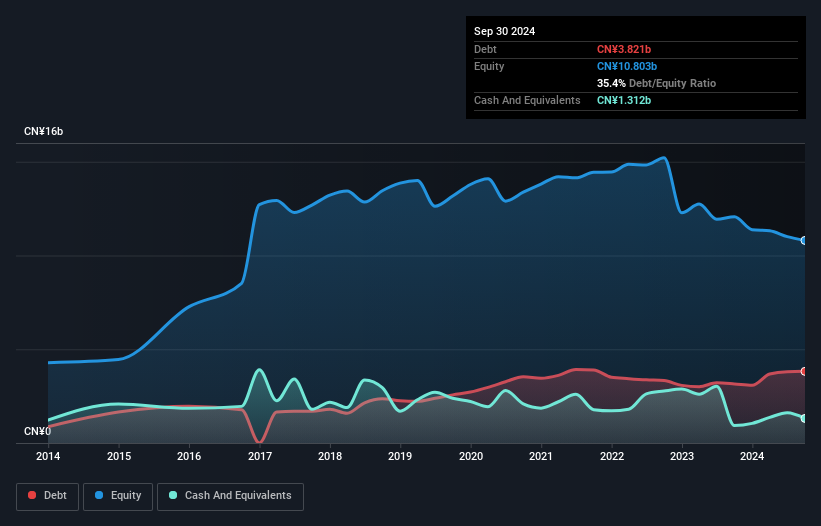The external fund manager backed by Berkshire Hathaway's Charlie Munger, Li Lu, makes no bones about it when he says 'The biggest investment risk is not the volatility of prices, but whether you will suffer a permanent loss of capital.' So it might be obvious that you need to consider debt, when you think about how risky any given stock is, because too much debt can sink a company. As with many other companies Shandong Buchang Pharmaceuticals Co., Ltd. (SHSE:603858) makes use of debt. But the real question is whether this debt is making the company risky.
Why Does Debt Bring Risk?
Debt assists a business until the business has trouble paying it off, either with new capital or with free cash flow. In the worst case scenario, a company can go bankrupt if it cannot pay its creditors. However, a more common (but still painful) scenario is that it has to raise new equity capital at a low price, thus permanently diluting shareholders. Of course, debt can be an important tool in businesses, particularly capital heavy businesses. When we think about a company's use of debt, we first look at cash and debt together.
What Is Shandong Buchang Pharmaceuticals's Net Debt?
You can click the graphic below for the historical numbers, but it shows that as of September 2024 Shandong Buchang Pharmaceuticals had CN¥3.82b of debt, an increase on CN¥3.15b, over one year. On the flip side, it has CN¥1.31b in cash leading to net debt of about CN¥2.51b.

A Look At Shandong Buchang Pharmaceuticals' Liabilities
 According to the last reported balance sheet, Shandong Buchang Pharmaceuticals had liabilities of CN¥6.08b due within 12 months, and liabilities of CN¥3.27b due beyond 12 months. Offsetting this, it had CN¥1.31b in cash and CN¥1.48b in receivables that were due within 12 months. So its liabilities total CN¥6.55b more than the combination of its cash and short-term receivables.
According to the last reported balance sheet, Shandong Buchang Pharmaceuticals had liabilities of CN¥6.08b due within 12 months, and liabilities of CN¥3.27b due beyond 12 months. Offsetting this, it had CN¥1.31b in cash and CN¥1.48b in receivables that were due within 12 months. So its liabilities total CN¥6.55b more than the combination of its cash and short-term receivables.
This deficit isn't so bad because Shandong Buchang Pharmaceuticals is worth CN¥17.8b, and thus could probably raise enough capital to shore up its balance sheet, if the need arose. But we definitely want to keep our eyes open to indications that its debt is bringing too much risk.
We measure a company's debt load relative to its earnings power by looking at its net debt divided by its earnings before interest, tax, depreciation, and amortization (EBITDA) and by calculating how easily its earnings before interest and tax (EBIT) cover its interest expense (interest cover). The advantage of this approach is that we take into account both the absolute quantum of debt (with net debt to EBITDA) and the actual interest expenses associated with that debt (with its interest cover ratio).
Shandong Buchang Pharmaceuticals's debt is 2.7 times its EBITDA, and its EBIT cover its interest expense 5.4 times over. This suggests that while the debt levels are significant, we'd stop short of calling them problematic. Shareholders should be aware that Shandong Buchang Pharmaceuticals's EBIT was down 57% last year. If that decline continues then paying off debt will be harder than selling foie gras at a vegan convention. There's no doubt that we learn most about debt from the balance sheet. But you can't view debt in total isolation; since Shandong Buchang Pharmaceuticals will need earnings to service that debt. So if you're keen to discover more about its earnings, it might be worth checking out this graph of its long term earnings trend.
Finally, a company can only pay off debt with cold hard cash, not accounting profits. So it's worth checking how much of that EBIT is backed by free cash flow. During the last three years, Shandong Buchang Pharmaceuticals produced sturdy free cash flow equating to 72% of its EBIT, about what we'd expect. This free cash flow puts the company in a good position to pay down debt, when appropriate.
Our View
Shandong Buchang Pharmaceuticals's struggle to grow its EBIT had us second guessing its balance sheet strength, but the other data-points we considered were relatively redeeming. For example its conversion of EBIT to free cash flow was refreshing. We think that Shandong Buchang Pharmaceuticals's debt does make it a bit risky, after considering the aforementioned data points together. That's not necessarily a bad thing, since leverage can boost returns on equity, but it is something to be aware of. The balance sheet is clearly the area to focus on when you are analysing debt. But ultimately, every company can contain risks that exist outside of the balance sheet. For example Shandong Buchang Pharmaceuticals has 2 warning signs (and 1 which shouldn't be ignored) we think you should know about.
Of course, if you're the type of investor who prefers buying stocks without the burden of debt, then don't hesitate to discover our exclusive list of net cash growth stocks, today.
Have feedback on this article? Concerned about the content? Get in touch with us directly. Alternatively, email editorial-team (at) simplywallst.com.
This article by Simply Wall St is general in nature. We provide commentary based on historical data and analyst forecasts only using an unbiased methodology and our articles are not intended to be financial advice. It does not constitute a recommendation to buy or sell any stock, and does not take account of your objectives, or your financial situation. We aim to bring you long-term focused analysis driven by fundamental data. Note that our analysis may not factor in the latest price-sensitive company announcements or qualitative material. Simply Wall St has no position in any stocks mentioned.

